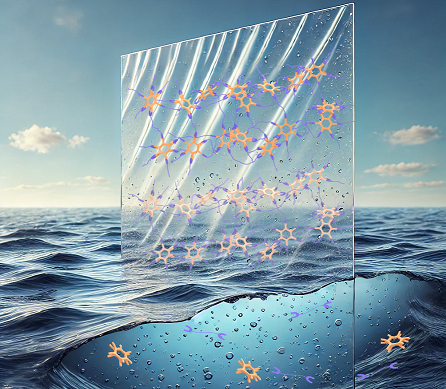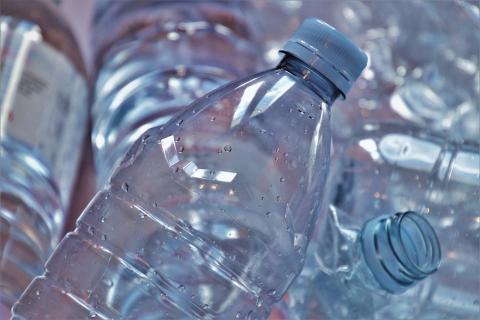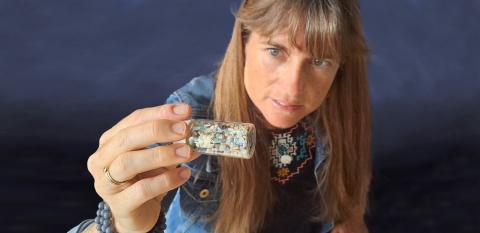Scientists develop a plastic that degrades in the ocean without polluting
A study published today in Science reveals a new plastic as durable as conventional plastics that decomposes in seawater. According to the authors, this new material could help reduce microplastic pollution accumulating in the oceans and eventually entering the food chain.

Artistic rendering of the new plastic. Cross linked salt bridges visible in the plastic outside the seawater give it its structure and strength. In seawater, resalting destroys the bridges, prevending microplastic formation and allowing the plastic to become biodegradable. Credit: RIKEN.
Joaquín Martínez - nuevo plástico
Joaquín Martínez Urreaga
Researcher at the Department of Industrial Chemical Engineering and the Environment of the School of Industrial Engineering.
This work is of great interest because it proposes, in a solid and credible manner, a new alternative to reduce the issue of plastic waste pollution, particularly in seas and oceans. The alternative is based on a new type of plastic, completely different from conventional ones. The proposed plastics have good properties and practical applications; moreover, they can be easily recycled and decompose rapidly in seawater without causing pollution.
The most widely used conventional plastics today are composed of large molecules where atoms and molecules are bonded by strong links that resist microorganisms and environmental agents such as water, light, oxygen, or heat. This makes them durable and causes improperly disposed or poorly managed waste to decompose slowly, polluting the entire environment.
In contrast, the proposed plastics are made up of moderately sized molecules that are, most importantly, joined by bonds that are strong but can easily be broken under the right conditions. These bonds are formed by extracting salts from the reaction medium and can be broken simply by replenishing the salts. This can be achieved through a recycling process for recovering the starting components and can also occur naturally in the sea. The salinity of seawater itself could decompose these plastics, regenerating the starting units, which can also be environmentally friendly, thereby reducing the problem of pollution.
This work, conducted by researchers from the Riken Center, the University of Tokyo, and the Eindhoven University of Technology (NL), is entirely robust from a scientific perspective, featuring a comprehensive set of well-designed and executed tests, as well as a sound analysis of the results. This substantiates the conclusions drawn and makes the proposal viable.
However, it is unrealistic to expect this proposal to immediately solve the problem of plastic waste pollution. Further engineering and economic studies are needed to implement the process on a large scale. The vast quantity of conventional plastics currently in use makes their complete replacement in the short term extremely challenging. Therefore, efforts must continue in areas such as reducing plastic consumption and improving waste management to mitigate pollution and enhance resource utilization.
Nonetheless, there is no doubt that the proposal presented in this work is scientifically grounded and could effectively contribute to reducing pollution. It is therefore worth promoting.
Ethel - nuevo plástico
Ethel Eljarrat
Director of the Institute of Environmental Assessment and Water Studies (IDAEA-CSIC)
The study published in Science represents a breakthrough in the development of more sustainable plastic materials. Researchers have succeeded in creating a new type of plastic that is just as durable as conventional plastics but capable of breaking down in seawater. Considering that one of the key criteria for plastics suitable for a sustainable future is their ease of biological degradation—particularly when they unintentionally end up in marine environments—this study marks a significant step forward. Furthermore, the developed material would also prevent pollution caused by microplastics, which have already invaded all our seas and oceans.
However, it is important to remember that another critical criterion for new materials to be considered sustainable is that they must not be toxic to humans or the environment. Plastics are often associated with a wide range of chemical additives used to provide specific properties. Scientific evidence suggests that many of these chemicals are toxic to human health and the environment. Some new materials developed in recent years are more fragile than conventional plastics, requiring larger amounts of chemical additives, which increases their potential toxicity. Unfortunately, this is an often-overlooked but vital aspect.
Additionally, the extent to which these chemical compounds are released once the material decomposes in seawater should also be evaluated. The dispersion of these toxins in marine environments would not constitute a sustainable solution either.
Cheng et al.
- Research article
- Peer reviewed



